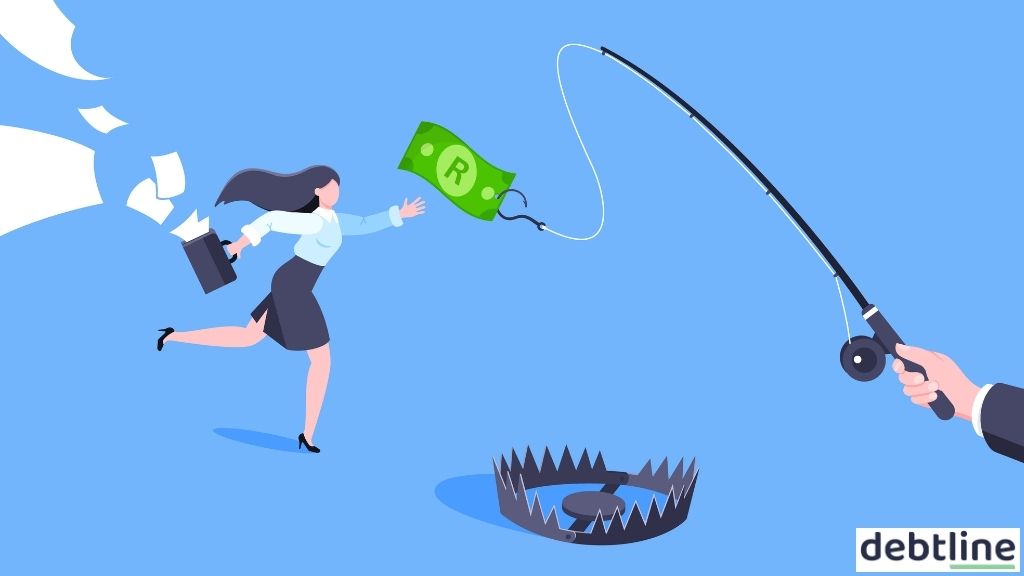What is the Debt Trap in South Africa?

One thing that is undeniable is that an increasing number of South Africans are really feeling the pressures of credit and falling into a debt trap. These financial pressures are making it extremely difficult for many South Africans to get ahead of all their debts.
South Africans have a debt of R2.31 trillion, and between July and September 2023, a further R142.26 billion of new credit was added, as per the National Credit Regulator.
Read: Real Debt Trap Solutions for South Africans
The biggest concern is that nearly half of the 27 million South Africans with credit are around three or more months behind on their repayments. This fact leads to many falling into a dangerous debt trap.
What is a Debt Trap?
According to the consumer financial journalist Maya Fisher-French, the biggest problem is that we are committing too much of our future income to something we bought in the past.
The focus is shifted to what is considered necessary right now, which locks South Africans in long-term commitments. According to Fisher-French, ‘one of the biggest things credit providers have done is making these lump sum big expenses appear cheap by making it a monthly instalment.’
Read: 7 Types of Debt in South Africa and How To Manage It
This is essentially a debt trap, where a borrower may feel forced to take out new loans to repay the existing ones. A debt trap occurs when your obligations surpass your capacity for loan repayment.
How to Avoid a Debt Trap
One thing nobody will deny is that getting out of a debt trap can be very stressful. Most prefer to avoid falling into a debt trap altogether. How does one avoid stepping into the debt trap?
To avoid the debt trap, you need to start planning for all your current and future financial needs. It’s important to assess your current financial situation and only take out debt that you are capable of repaying. Preferably, avoid making debt unless it’s absolutely necessary.
With a high interest rate that keeps increasing the debt amount, it’s best to refrain from making undeclared debt. Also, always try to pay back more than the required amount monthly. At the same time, the set amount may seem viable due to the increase in high interest rates; paying off more over a longer period of time can lead to being trapped in debt.
Read: South Africans are Taking Control of Household Debt
If you want to truly manage your debt, you need to analyse the different types of debts you currently have to align with their interest rates. Then, add it all together and create a payback plan that can get you out of debt quickly. Start prioritising the debts with the highest interest rates.
- Create an emergency fund – To avoid a debt trap, make sure you have an emergency fund. Ideally, you want up to six months’ salary set aside for emergencies.
- Consolidate many loans into a single one – Take the different loans and consolidate them into one loan to simplify your life and help with repayments.
- Keep an eye on your monthly expenses – We often splurge or spend funds on unnecessary things. By creating a budget and checking your monthly budget expenses, you can start cutting out any wasteful expenses.
- Refrain from impulse spending – Don’t use your credit card or any form of debt to buy things unless absolutely necessary. Think before purchasing anything via credit, and be sure to review and cut your regular spending.
- Income to expenses ratio – Review your current expenses to income ratio and make sure the fixed expenses to income ratio is not more than 50%.
- Take a pause – If you find that you’ve increased and exhausted your credit card limit more than once, you may want to take a moment to pause and reflect. This is a possible debt trap you’re falling into.
Tips to go debt-free:
- Create a budget.
- Pay off your smallest debts first.
- Contact creditors to try to reduce your interest rates.
- Don’t make any more new debt.
- Start building an emergency fund to prevent future debt spirals.
- Get help from professionals if you’re struggling to manage by yourself.
Let Debtline Be Your Guide
Most South Africans struggle with too many loans and can’t afford to put money into savings monthly. This is concerning, considering many are opting to take advantage of the two-pot retirement funds to cut down their current debts, while others are using them to continue spending on lavish items and luxury getaways.
Read: How To Tackle South Africa’s Biggest Financial Challenges
If you find yourself tired of the same debt cycle, Debtline is here to help. We’ve got NCR-registered counsellors who can provide advice and assistance on your journey to financial freedom. You can also get assistance and protection while undergoing a Debt Review.
Debtline helps South Africans climb their way back to financial stability with tailored plans that fit their budget. Contact the Debtline team for a free callback and start today.